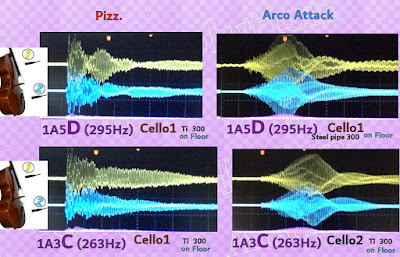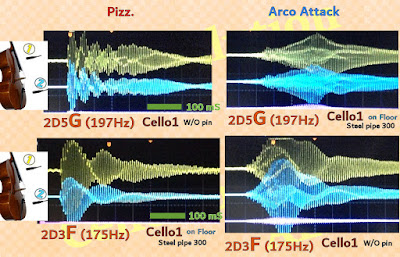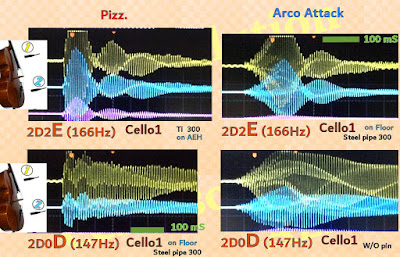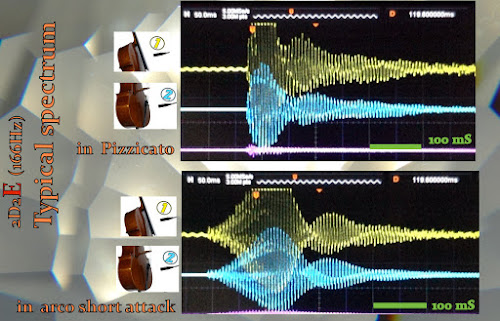[ 09/19/2020 ] Labels: 61..Sound color-2
Typical tone portraits(oscilloscope waveform) of cello from C(66Hz) up to A(442Hz) have been posted up to now. These photos, oscilloscope's horizontal lattice was set as 50mS, show us two important facts.
(1) There is a regularity/resemblance in the tone portraits according to the tone name such as C,D,E,F,G,A,, when they are played by pizzicato, beyond octaves or cello instruments or endpins. This phenomenon is probably originated in the cello body structure and its dimensions.
(2) Cello seems to be able to create a single-beat waveform(noiseless, beautiful) for tones G(98Hz) and above. Skilled cello players can probably create such a simple waveform even on arco-tones. On the other hand, for low frequency notes(C:66Hz to F#:93Hz), cello body is too short to create such a long wavelength by its single-beat. When an endpin is not equipped, cello recruits some additional regular up-beats(1-4 times) by itself inside the body to make up a complete fundamental period. However if the endpin is anchored on the floor and given continuous energy, the long length wave goes through to endpin and rebounds at the floor, then brings back a noisy/interference vibration and reduces the original tone amplitude instead.
There seem to be a discontinuity fault in the resonance in and around G(98Hz) tone.
Here attached typical portrait photos of C(66Hz), G(98Hz) and D(147Hz) that are set H-lattice as 20mS to improve the resolution.
チェロの最低音(C,66Hz)からA(442Hz)までの主要音についてオシロスコープの波形(水平格子=50mS設定)を見てきた。ここでは2つの特徴があることに気づく。
(1) ピチカートから得られる共鳴波形は、音名ごとに極めて類似した姿をしている。これは、楽器が変わっても床とエンドピンの関係が変わってもあるいはオクターブが違っても共通に現れる類似形のようだ。つまり、チェロという構造・ディメンションからもたらされているように思われる。
(2) G(98Hz)以上の高音においては、全ての音でその音の基音周波数によるシンプルで美しい波形を得ることができるようだ。(厳密にはボーイング時においては一定のスキルは必要。) しかし、低音のC-F#(C線上)においては基音のみの純粋な音を得ることができない。つまり、チェロ胴体が95Hz程度以下のシングルビートを作ることができないことを意味する。エンドピンが無い時は裏拍(1-4ケ、⇒倍音とも関係がある)を補足しながらその基音周期を形成している。エンドピンが装着され床に固定され、弓を使って連続してエネルギーが供給される場合、そのエネルギーは床に向かって(長周期を求めて)流れて行く。そのリバウンド波は規則的な裏拍を形成できないで雑音のようにフィードバックされ、C-F#ではその雑多な振動が混在する。
チェロは、G(98Hz)の上下で響きのルカニズムが異なっている。
添付の写真は、C(66Hz)、G(98Hz)、D(147Hz)の典型的な波形である。ここでは水平格子幅を20mSに拡大してある。C(66Hz)ではピチカートの場合、3-4ケの裏拍を伴って15mSの基音周期を形成しているのがわかる。
















